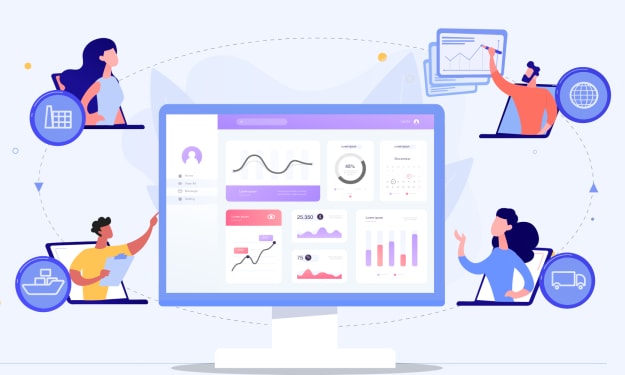A Complete Guide To Controlling ERP Implementation Cost
There are several ways to keep your ERP project expenses under control.

Summary: In this blog post we are going to explain various ERP cost components and how to have better control over your ERP implementation budget.
Let’s begin with the basic saying that ERP implementation is primarily done by businesses to control long term operational costs and to streamline business processes. So, both cost reduction and boosting efficiency are two primary reasons for implementing ERP software by a business.
But, now comes the spin. Even for ERP implementation businesses need to bear huge costs. Question is, how far this cost can be reduced and what are the key ways to bring this cost down. Well, based on the successful implementation experience of various companies, we can explain some time-tested measures. But before that let’s begin by explaining the key cost components in the ERP implementation process.
The Key Components Affecting ERP Implementation Cost
ERP software implementation needs to bear some statutory as well as variable costs including licensing fees, infrastructure costs, third party integration, data conversion, custom development, testing, training and post-implementation support. Understanding these cost components is important to have a solid grasp of the ERP implementation budget. Here below we explain key cost components one by one.
ERP Licensing Fees
The first and foremost cost component that ERP clients need to bear in the very beginning is the licensing fee for the ERP software. Well, this cost varies from one software to another. Another variable cost factor is the number of users and the software version you choose. Some ERP software offers separate versions for small and medium businesses and large enterprises.
ERP Infrastructure, Servers And Network
This is another key cost component affecting the overall cost of the ERP implementation project. Whether you choose on-premise server support or a cloud-based SaaS solution, can impact the recurring cost to a great extent. Even among the so-called cloud-based SaaS ERP software solutions, you can have several server and network hardware options with different cost tags.
Data Conversion And Legacy Software Integration
The third big cost component for ERP implementation projects is the conversion of business data to new compatible formats and the transfer of data from legacy software systems to the new ERP system. The more flexible an ERP solution you choose regarding compatibility and ease of data transfer from legacy software systems, the greater the cost advantage you can get for this component. Some ERP software solutions like Netsuite by allowing easy integration of legacy software such as Quickbooks reduce both integration costs and concerns.
ERP Customization
One big cost component which is not present in all ERP implementation cases is customisation. ERP customisation can be carried out through the business-specific custom configuration of the modules, apps and tools and custom app development for ERP automation. Coding custom scripts for particular functions within an ERP involves a bigger cost than simple custom configuration. The cost will increase as the business opts for increased customisation options.
ERP Testing
Every ERP software after implementation should pass through rigorous testing involving different departments and business functions. The cost will depend upon the rigorousness of the testing process and the number of functional apps and modules of the ERP software that are undergoing implementation and testing.
Employee Training
A major cost component that accompanies an ERP implementation project is employee training. After the ERP software is up and running, the employees must be well versed to use it efficiently and productively. Often after switching from traditional business management software to a new ERP system, employees need the training to get well with the ERP modules or process automation. The cost of post-implementation training depends upon the number of users and the length of the ERP implementation project.
Post-Implementation Support
Last but not least cost component is the post-implementation support by the ERP vendor or the ERP implementation company. This cost may vary depending upon the vendor. But it is advisable to give optimum importance to post-implementation support and keep cost consideration a second priority regarding ERP support.
How to Reduce ERP Implementation Costs?
Ultimately, every business when implementing a new ERP software wants to have better control over the budget. Now that you have a basic understanding of all the cost components of an ERP software implementation, we must guide you in reducing the cost of implementing an ERP software. Let’s explain the cost reduction measures one by one.
Validate The ERP Software Cost
The decision to implement a new ERP software must be justified by the business gains it delivers to your company. If the ERP implementation cannot boost efficiency, make employees more productive and speed up lead generation and business conversion, the ERP implementation is not of any value. This is why every ERP implementation should have an ROI growth projection in the post-implementation period.
Can the ERP software automate most of the repetitive and time-consuming tasks to free up a big chunk of productive time? Is the ERP software capable of driving data-driven and real-time business intelligence for more accurate decision making and strategic business planning? Can the ERP software speed up the cash cycle or sales conversion or delivery process by automating tasks to ensure more revenue generation? These are the key questions to ask for justifying the cost of ERP software and its implementation.
Plan And Budget Carefully
In most cases, in the absence of a detailed ERP implementation plan and corresponding budget, the cost can significantly grow and you may lose control of the spending. On the other hand, meticulous planning will always help you to stay within the limit of the original implementation scope and corresponding budget. A clear understanding of everything you need from the software package and the specific integration and customisation you require will give you better control.
Do you have an alternative plan ready when one app or module fails to provide satisfactory results? Did you figure out what you can do when the implementation goes wrong or just fail to transfer data from the legacy software systems? Did you chalk out the issues corresponding to the outdated IT infrastructure in your workplace while implementing the ERP software? What about the security vulnerabilities and issues emerging out of mobile ERP access? Careful planning will help you come out with an answer every time you get stuck with these concerns.
Deciding The Right Pricing Model
In the market, we have mainly two leading pricing models for ERP software products with their respective pros and cons. We also have some hybrid models that incorporate attributes of the two principal models. Let’s first try to understand the differences and the pros and cons of the two main pricing models.
The On-Premise Model
As per this model, a business can host the ERP software on the servers within their company premise. Because of the bigger cost and on-premise infrastructure management responsibilities, this model is more suitable for large enterprises. For smaller companies, there are several challenges to embracing this model. The biggest challenge is the initial cost of establishing on-premise hardware.
The cost advantages of this model include the following:
Predefined cost of owning the entire ERP software suite
Single time licensing cost and freedom from recurring subscription cost
Low cost of ERP in the long run
The key cost shortcomings of this model include the following:
The large initial cost for server infrastructure
Scalability issues in the long run when the business expands and grows.
Cloud-Based SaaS Model
As businesses are increasingly turning to the cloud instead of the on-premise server, the cloud-based SaaS (Software as a Service ) model is getting popular rapidly. This model requires no large infrastructure cost and offers great flexibility and scalability that suits businesses of all sizes. The only cost the customers of this ERP model need to bear is the subscription fee.
The key cost advantages of the cloud-based SaaS model include the following.
Affordable and flexible monthly or yearly subscription costs that can be scaled up or down based on the number of users.
The very low initial setup cost is because of the cloud hosting.
Highly scalable and flexible solution to accommodate evolving requirements.
Some of the key cost shortcomings of the cloud-based SaaS model include the following:
Continuously payable subscription costs over years can take more cost than the permanent licensing and infrastructure cost of the on-premise model.
The cost can suddenly go up with the increasing demand.
Deciding The Right ERP Feature Set
A major risk for paying for more than what you require is when you choose a lot of ERP features that are unnecessary for your business. Such overselling of features and models with standard ERP packages can result in bearing a higher cost. On the other hand, if you fail to get all the features you require for the ERP software, future purchases or implementation may add up the cost. To avoid both of these situations, you need to meticulously plan the key ERP features and modules you need. Based on your budget and priority requirements, you need to select the must-have ERP features and modules.
Generally, across the industries, the must-have features and modules encompass accounting and financials, CRM, inventory management, etc. The choice of modules and features also depends upon the respective industry and the business niche. There are also industry-specific modules such as manufacturing, e-commerce, etc. Some of the most common modules used across the industries include the following.
Financial and Operations (F&O)
Accounting & Bookkeeping
Customer Relationship Management (CRM)
Sales and marketing
Human Resource Management (HRM)
Supply Chain Management (SCM)
Warehouse Management
Inventory management
Purchase & Merchandise
Business Intelligence (BI) & Analytics
When choosing the features you should also remain flexible about accommodating business growth in the years to come and accordingly should keep certain features that are going to be essential in future. Cost considerations are okay as long as it does not create roadblocks to growth opportunities for the business.
Utilise The Expertise Of The ERP Partner
For any business with zero or minimum technical exposure and experience, it is always advisable to get on board an ERP implementation company or ERP consultancy to take care of the implementation tasks in a responsible manner. Make sure the consultant company is experienced enough to handle ERP implementation for similar companies and has expertise in handling challenges similar to yours.
Remember, an ERP implementation or consulting company will play a key role in all aspects of the ERP project starting from feature and module selection to business process and operational management, task automation and ongoing change management. Besides hiring the most credible experts for the ERP implementation job you also need to utilise their expertise to the optimum level.
Concluding Remarks
So, having complete control over the ERP implementation cost is not difficult if you follow the above-mentioned measures and tips and do not fail to stick to a well-articulated and meticulous implementation plan and roadmap. Most ERP implementation projects end up over-spending just because of the lack of homework and planning. This is exactly what the above measures are meant to focus upon.
Original Source : VNMT Solutions
About the Creator
VNMT Solutions
VNMT Solutions is a NetSuite alliance partner and consultant solution provider with a global footprint and industry-acclaimed services. Starting our journey in 2017 and headquartered in Melbourne, Australia.
https://www.vnmtsolutions.com






Comments
There are no comments for this story
Be the first to respond and start the conversation.